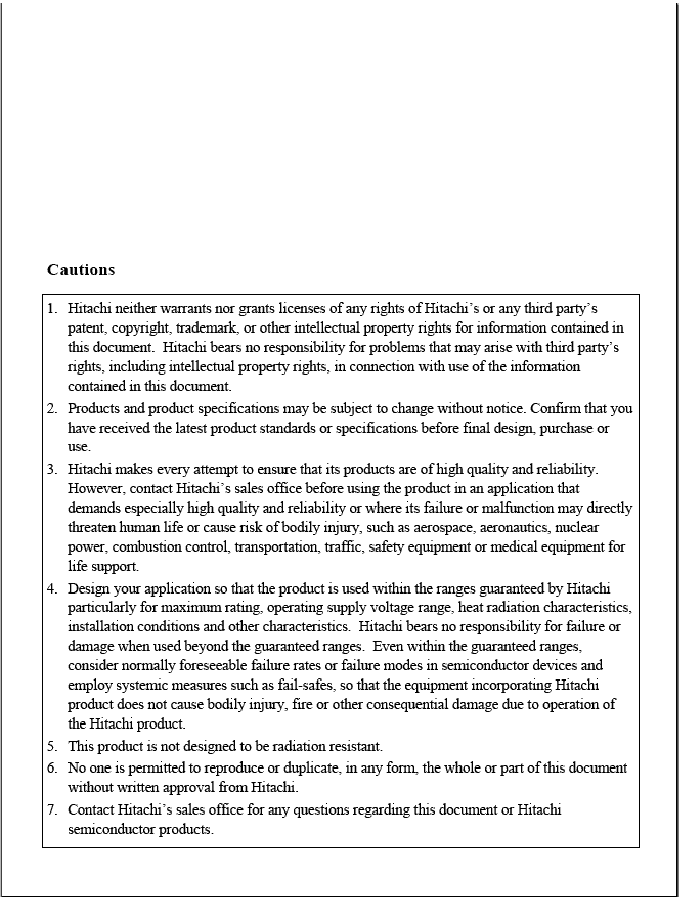
Preface
The H8/300L Series of single-chip microcomputers has the high-speed H8/300L CPU at its core,
with many necessary peripheral functions on-chip. The H8/300L CPU instruction set is
compatible with the H8/300 CPU.
The H8/3937 Series and H8/3937R Series include, a FLEXTM decoder*, five kinds of timers, a 2-
channel serial communication interface, and an A/D converter, as on-chip peripheral functions
necessary for system configuration. The configuration of these series makes them ideal for use as
embedded microcomputers in pagers using the FLEXTM decoder system.
The H8/3937 Series supports non-roaming, while the H8/3937R Series supports roaming.
This manual describes the hardware of the H8/3937 Series and H8/3937R Series. For details on
H8/3937 Series and 3937R Series instruction set, refer to the H8/300L Series Programming
Manual.
Note: * FLEX is a trademark of Motorola Inc.

i
Contents
Section 1
Overview
............................................................................................................
1
1.1 Overview ............................................................................................................................
1
1.2
Internal Block Diagram ......................................................................................................
5
1.3
Pin Arrangement and Functions.........................................................................................
6
1.3.1 Pin
Arrangement ...................................................................................................
6
1.3.2 Pin
Functions.........................................................................................................
7
Section 2
CPU
.....................................................................................................................
13
2.1 Overview ............................................................................................................................ 13
2.1.1 Features .................................................................................................................
13
2.1.2 Address
Space.......................................................................................................
14
2.1.3 Register
Configuration .......................................................................................... 14
2.2 Register
Descriptions .........................................................................................................
15
2.2.1 General
Registers .................................................................................................. 15
2.2.2 Control
Registers...................................................................................................
15
2.2.3
Initial Register Values...........................................................................................
16
2.3 Data
Formats ...................................................................................................................... 17
2.3.1
Data Formats in General Registers .......................................................................
18
2.3.2
Memory Data Formats .......................................................................................... 19
2.4 Addressing
Modes.............................................................................................................. 20
2.4.1 Addressing
Modes.................................................................................................
20
2.4.2
Effective Address Calculation...............................................................................
22
2.5 Instruction
Set .................................................................................................................... 26
2.5.1
Data Transfer Instructions.....................................................................................
28
2.5.2 Arithmetic
Operations...........................................................................................
30
2.5.3 Logic
Operations...................................................................................................
31
2.5.4
Shift Operations .................................................................................................... 31
2.5.5 Bit
Manipulations.................................................................................................. 33
2.5.6 Branching
Instructions .......................................................................................... 37
2.5.7
System Control Instructions.................................................................................. 39
2.5.8
Block Data Transfer Instruction............................................................................ 40
2.6
Basic Operational Timing .................................................................................................. 42
2.6.1
Access to On-Chip Memory (RAM, ROM) .........................................................
42
2.6.2
Access to On-Chip Peripheral Modules................................................................ 43
2.7 CPU
States .........................................................................................................................
45
2.7.1 Overview...............................................................................................................
45
2.7.2
Program Execution State.......................................................................................
46
2.7.3
Program Halt State ................................................................................................ 46
2.7.4 Exception-Handling State .....................................................................................
46




